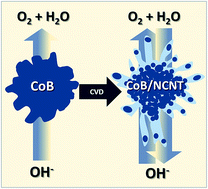Cobalt boride modified with N-doped carbon nanotubes as a high-performance bifunctional oxygen electrocatalyst†
Abstract
The development of reversible oxygen electrodes, able to drive both the oxygen evolution reaction (OER) and the oxygen reduction reaction (ORR), is still a great challenge. We describe a very efficient and stable bifunctional electrocatalytic system for reversible oxygen electrodes obtained by direct CVD growth of nitrogen-doped carbon nanotubes (NCNTs) on the surface of cobalt boride (CoB) nanoparticles. A detailed investigation of the crystalline structure and elemental distribution of CoB before and after NCNT growth reveals that the NCNTs grow on small CoB nanoparticles formed in the CVD process. The resultant CoB/NCNT system exhibited outstanding activity in catalyzing both the OER and the ORR in 0.1 M KOH with an overvoltage difference of only 0.73 V between the ORR at −1 mA cm−2 and the OER at +10 mA cm−2. The proposed CoB/NCNT catalyst showed stable performance during 50 h of OER stability assessment in 0.1 M KOH. Moreover, CoB/NCNT spray-coated on a gas diffusion layer as an air-breathing electrode proved its high durability during 170 galvanostatic charge–discharge (OER/ORR) test cycles (around 30 h) at ±10 mA cm−2 in 6 M KOH, making it an excellent bifunctional catalyst for potential Zn–air battery application.

- This article is part of the themed collection: 2017 Journal of Materials Chemistry A HOT Papers


 Please wait while we load your content...
Please wait while we load your content...